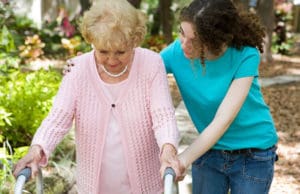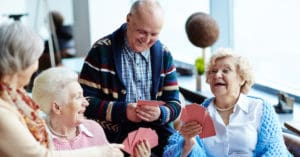-
By Sherri Snelling Caregiving Expert
Part of the TRANSFORMING LIFE AS WE AGE SPECIAL REPORT
It all started with a fifth-grade class project. Scott Tarde, CEO of George G. Glenner Alzheimer’s Family Centers, which has operated dementia day care facilities in California’s San Diego county for 35 years, was amazed at his 12-year-old daughter’s enthusiasm over her Junior Achievement “BizTown” field trip.
In a huge space not unlike a converted shopping mall, the young students took on civic roles such as mayor, bank teller and restaurant owner. The goal was to immerse children in what it takes to run a city and understand the economy.
For Tarde, a lightbulb went on.
Time Capsule Therapy for People With Dementia
For the more than 5 million Americans who have Alzheimer’s, their minds are trapped in a world often many years in the past. Short-term memory loss is common; they may not recognize younger members of the family such as grandchildren. Yet, long-term memories often remain intact. They recall days of their youth and may think an adult son is actually their husband or long-deceased father.
Glenner Town Square will be a dementia village-style environment that envelopes patients in a world they know but which has been gone for over 50 years.
Triggering positive memories from the past is often the goal of families and dementia-care professionals. An approach called reminiscence therapy (RT), initially presented by renowned geriatrician Robert Butler and noted psychologist Erik Erikson, can help dementia patients calm anxiety, soothe aggressive behavior, prevent wandering and improve quality of life, studies have shown.
Tarde and his business development director, Lisa Tyburski, were already using RT in their dementia day care facilities. They wanted to take the concept to a new level. Their vision is to create a completely immersive experience — a faux Main Street U.S.A. circa 1953 to 1961, when many of their dementia patients were in their younger years. Their research led them to the first dementia village. It was created in The Netherlands in 2009 and is called Hogeweyk; dementia residents and health care professionals all live in the same enclosed village.
 An Old Model for a New Idea
An Old Model for a New Idea
But while Hogeweyk is a 24/7 residential care town with several city blocks, it doesn’t offer the retro style that Tarde and team are building in San Diego, called the Glenner Town Square. And Glenner is a day program, not a residential center.
The “town” encompasses 8,500 square feet, 24 buildings and 12 storefronts — including a diner, Post Office, barbershop, pet store, library, museum and even a movie theater. In it, dementia patients will be able to spend the day exploring this world independently, in small groups or with their families. It offers a secure environment, with the watchful eye of Glenner dementia care professionals operating the storefronts and other businesses and interacting with the patients throughout the day.
The $3 million Glenner Town Square will be built in collaboration with the San Diego Opera Scenic Studio using the artisans and production staff who create the environments and sets for the stage. It is scheduled to open in 2018 and will be the first “dementia village” in the U.S.
Tyburski advises that this is just the beginning. The plan is to build these villages first throughout California, and then to expand nationally. Other long-term care communities across the country may have a nostalgia room with décor and photos, such as The Easton Home near Philadelphia, but Glenner Town Square will be the first planned, and completely standalone, dementia village-style environment that envelopes the dementia patients in a world they know well but which has been gone for more than 50 years.
“A lot of thought and planning has gone into the Town Square,” says Tyburski. “For instance, we found a Hollywood prop company, History for Hire, that can provide any era furniture and other décor, and we are creating fire hydrants and other street props made of rubber or fiberglass, so they are safe for our patients.”
Memory-Triggering Details
And while the Glenner Town Square will evoke an earlier era resembling any town across the country, each village built will have some local flavor that may help trigger memories for Glenner’s Alzheimer’s patients. In this first Town Square in San Diego, an Old Town gaslight street and Navy Town section represent the real local area attractions that have been part of San Diego for decades and still exist today.
Tom Christian, an architect whose wife Grace was diagnosed with frontotemporal dementia in 2012 at age 52, finds the Glenner Town Square concept revolutionary in dementia care.
“Grace needs a lot of different activities and stimulation throughout the day to keep her from picking up objects and pacing with them,” he says. “While the current adult day care activities have helped, the idea of her having a whole ‘town’ to explore, with familiar but different settings in a controlled space, with safe confines and expert supervisors during the day, is a breakthrough for us.”
 A Happier Place on Earth
A Happier Place on Earth
It seems appropriate that Southern California will be the site of the nation’s first dementia village, and the 1950s timeframe is also suggestive of a similar genius concept. After all, it was July 1955 when a visionary named Walt Disney transformed a 160-acre orange grove in Anaheim, Calif., and created Frontierland, Adventureland, Fantasyland and Tomorrowland — a place for families to immerse themselves in other worlds. Glenner Town Square is embarking on a new era in dementia care, providing the same intergenerational opportunities and sparks of joy that are a hallmark of the Disney theme parks.
“Reminiscence therapy can be a powerful tool for dementia patients,” says Dr. Peter Whitehouse, professor of neurology and neuroscience at Case Western University and president of the Intergenerational Schools International. “It makes those with Alzheimer’s more content and happier because they return to a time in their lives when there was no perceived failure — a time when their memory was intact and they did not feel lost.”
Whitehouse adds that combining RT with the actual historic environment is not only a powerful therapeutic solution for those with dementia, but also engages family members who may have been at a loss as to how to interact and elicit communication with their loved one.
“Both children and seniors, including those with a dementia diagnosis, can feel isolated, lonely and vulnerable,” Whitehouse adds. “Creating places where they can learn from, and interact with, each other creates a futuristic playground where each generation can create and share stories. Kids experience the past through the eyes of their elders and our seniors see the future in the eyes of the children.”
The Power of Reminiscing
Bob Partridge and his wife care for his 74-year-old mother-in-law, who was diagnosed with Alzheimer’s six years ago.
“My mother-in-law gets anxious, especially when she is more sedentary and does not get a lot of activity,” says Partridge. “We believe the Town Square concept gives us a chance to involve her in a pleasant, calming but active setting that may help slow the progression of her disease. I know the idea of slowing Alzheimer’s is not scientifically proven — but we see that reminiscing about the past has a positive impact on her behavior and interaction with others, so we believe we can keep her engaged with us longer in this type of environment.”
Partridge also shares that his mother-in-law is challenged in interacting with her 17-year-old and 11-year-old grandchildren because of the barriers in communication that come with dementia. But he says this will offer them all a place to go and create new experiences based on his mother-in-law’s re-living memories of her past.
“Having my mother-in-law be able to talk to her grandkids about her early years is a blessing we believe will come out of this experience in a natural and spontaneous way that the grandkids can appreciate,” adds Partridge. “We support more funding to help find a cure for Alzheimer’s, but in the meantime, families need help with the care of dementia loved ones.”
The Way We Were
Tom Christian also shares that the idea of Glenner Town Square changes his perspective on his caregiving role and believes it may also help eliminate the stigma that’s typical with an Alzheimer’s diagnosis.
“With the adult day care center, I drop Grace off and then pick her up — it isn’t something we share together and that was a special and important component of our relationship — our togetherness,’ says Christian. “And while Grace and I go places together, it is sometimes hard to explain to people that she has dementia and what that means. Sometimes I have felt a stigma in how people treat you.”
Christian says when Glenner Town Square opens, he and his wife will now have a place to go together. He believes these types of advancements in dealing with the dignity of dementia families are important.
“A diagnosis of dementia doesn’t have to mean the end of your life. I’ve been able to see it isn’t a bad thing, it’s just different,” says Christian. “Grace and I always said we both wanted a marriage where we spent as much time together as possible. The idea that we can stroll through a city street together and maybe go to a 1950s movie for a while creates a positive for me out of a not-so-positive situation.”
He adds: “I don’t want to trivialize dementia in any way, but there can still be joy and magic moments to be shared and this gives us a place to do that.”
Next Avenue Editors Also Recommend:
-
To Help Ward Off Alzheimer’s, Think Before You Eat
-
The ‘Dude’ Approach to Dementia
-
Learn How Two Communities Prevent Social Isolation



 A Happier Place on Earth
A Happier Place on Earth

 It starts with acknowledging that you can’t do it all on your own
It starts with acknowledging that you can’t do it all on your own








 Taking these steps can reduce frustration and stress — for all of you
Taking these steps can reduce frustration and stress — for all of you
 7 tips to get mom or dad to go for care, meals and new friends
7 tips to get mom or dad to go for care, meals and new friends
